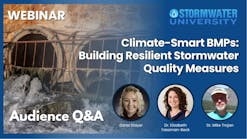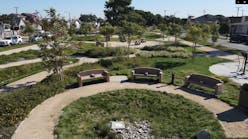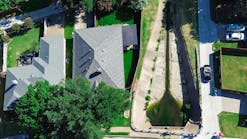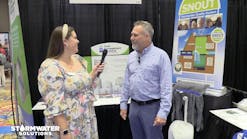Zachary Crear & Michael Frasco
undefinedLos Angeles is one of the fastest growing cities in the world, and space has become even more sensitive and limited than ever before.
“The county is facing a severe housing shortage, and a need for more housing and price-attainable housing,” said Diana Victoria Coronado of the Building Industry Assn.
High-density cities have simultaneous challenges. Land development is lucrative, and designers continuously are challenged by space, site constraints and regulations, so every square foot is maximized and justifiably scrutinized.
Since every new Los Angeles development must meet storm water pollution requirements in design, engineers and designers are finding relief with storm water solutions from credible companies with products that are flexible enough to fit their conservative intentions for the land, as well as goals for maximum value.
Situation
The Porter Ranch community of Los Angeles is in its initial phases, but this high profile master-planned living experience already has received attention and been awarded Builder of the Year by the Building Industry Assn. of Los Angeles & Ventura. Porter Ranch offers more than just an array of model home options—when the site reaches completion, it will feature “unrivaled amenities such as the new K-8 Porter Ranch Community School, the Porter Ranch Town Center, nature areas, hiking trails, the 14-acre Holleigh Bernson Memorial Park, a planned 50-acre park, and a planned high-end retail center,” according to Toll Brothers Inc.
The Porter Ranch geography and grading plan involves leading a significant amount of rainwater runoff and flow through a storm water treatment system, approved under the Stormwater Quality Management Plan (SWQMP), before discharging to the city of Los Angeles storm drain lines.
“The site’s geography, due to the hillside, made getting storm water to the onsite retention basins a challenge,” said Michael Frasco of Bio Clean Environmental. “In areas where retention was not possible, Modular Wetlands were implemented to achieve biofiltration treatment before discharging to the L.A. city storm drain.”
Challenge
Design engineers are faced with a set of challenges. The overall development may be spread out, but Porter Ranch’s steep hillsides, whose housing tracts consist of a network of drainage flumes and catch basins, make bioretention infeasible. Porter Ranch also is a master-planned development with an array of storm drain entry points such as curb inlets, grate inlets, drainage channels to catch basins (submerged pipe), etc. All these entry points are facilitating acres of newly terraced housing platforms, roof runoff and impervious areas that create very high volumes of storm water requiring treatment. Space restraints add to this already challenging set of obstacles. Los Angeles developments can be a lucrative endeavor, but buildable space is at a premium, and solutions that allow civil engineers and developers meet all these challenges within a small footprint and meet city regulations are rare.
According to the Los Angeles Water Quality Control Board, “Pollution conveyed by storm water degrades the quality of drinking water, damages fisheries and habitat of plants and animals that depend on clean water for survival. Pollutants carried by storm water can also affect recreational uses of water bodies by making them unsafe.”
The city of Los Angeles has championed initiatives and policies for protecting California’s water quality. The city holds storm water solutions to a high standard, and there is a selective process before systems are trusted to deploy on the front lines of mitigating pollution risks associated with construction.
Solution
Every Los Angeles real estate development comes with storm water approval challenges, but now solutions are much easier to assign. The widely adopted and proven Modular Wetlands storm water best management practice has been approved by the Los Angeles Water Quality Control Board for use as an “alternative compliance solution” for onsite biofiltration. Demonstrated to the board through third party verified testing, the system uses its high-performance media and patented horizontal flow for equivalent or better pollutant removal to standard biofiltration. In addition to this new Los Angeles approval, the system also has been issued Full Trash Capture Certification from the California State Water Resources Control Board, and the Washington State Department of Ecology Technology Assessment Protocol – Ecology program also has approved it for General Use Level Designation.
The Modular Wetlands gives engineers tasked with designing an efficient outcome a space savings solution to comply with low-impact development requirements. The system is an easily applicable, dependable and versatile option given space-conscious project and development criteria.
The Modular Wetlands patented horizontal flow design is the key. The system is the only proprietary solution available that can take advantage of multiple inlet configurations in a single system. In the case of this project, multiple area catch basins were routed to a single system and took advantage of a curb inlet. This adaptability minimizes the need for other catch basins on site.
The Modular Wetlands is customizable, allowing for height adjustments. The units on this project were all shallow installations, allowing for utilities to traverse under the systems for access to building pads and streetlights. The first phase of the Porter Ranch project implemented a Modular Wetlands System 8-16 model at a depth of merely 4 ft, 5 in., and some units were as shallow as 3 ft, 6 in. This is a huge advantage and benefit for engineers designing sophisticated runoff systems along the steep Santa Susana hillsides. The system also has the capability for built-in high-flow bypass. This allows the pretreatment chamber to be used as the primary catch basin and eliminate the need for another bypass structure.
[Visit Bio Clean's SWS Storefront]
The second phase of the Porter Ranch project implemented three Modular Wetlands systems to address drainage areas that could not be directed to onsite bioretention basins. Phases three through five are in process and will use Modular Wetlands systems to round out this luxury class-leading development in the highly desirable Porter Ranch district of Los Angeles.






